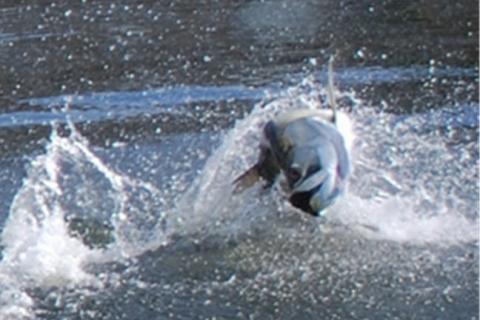
Not for everyone … or the weak at heart … or weak, in general.
Tarpon fishing is for the serious fishing person, dedicated to the sport of fishing -- not embarking on the quest of a trophy that breaks a world record, not seeking a personal challenge and not trying to catch the biggest fish amongst fishing buddies. Tarpon fishermen are committed to the sport, knowing that when the hookup comes, on the other end of the line will be a genuine adult freight train; there will be a fish pulling at a strength capacity most men have never encountered in their lifetime.
This is tarpon fishing at its best.
Where does one go to experience such fishing? The kind of fishing that leaves you trembling, aching up and down your back, your vision struggling to focus and your mouth trying to declare that the experience was almost surreal and most definitely the most exciting 60 minutes of a lifetime … so far. An experience that will bring you back time and time again, and that’s totally addictive.
In Key West, Florida, is a group of charter captains who earn their fees each day and, regardless of the accumulated financial resources, will continue to come back day after day just to see the event and to orchestrate a fishing experience for a client that he or she never knew existed.
If anyone who is reading this thinks I am exaggerating or “blowing smoke,” then you’ve never caught a tarpon of 150+ pounds. I have. My daughter has. One of the guys who works for me has -- actually, his was right at 225 lbs. Call our offices, ask for Sherri or Ken, and they will tell you! Sherri can even book a trip, complete with a captain reservation and a hotel minutes from the docks at Key West and within view of the room patio is where the tarpon will be caught.
Here is how it works:
It doesn’t matter what day or what time of day you hit the water. You just need to be there when the cruise ships come in to dock for a port-of-call docking. And when that happens … game on!
The captains move out and around the point at the Beach Resort hotel and head down the waterway with the Key West beach on the left and the Gulf on the right. They make a U-turn about a mile down and point the boats back in the direction from where they came -- north.
With medium- to medium-heavy saltwater fishing rigs, needlefish are slit onto the astonishingly small hooks. The fisherman is securely positioned in a fighting chair. The captain pulls line off and lets the reel free spool behind the boat as the boat moves slowly down the channel the cruise boats use to come and dock. All the while, the captains chums out pieces of needle fish, in essence, baiting the area.
The fisherman has got one job: watch his spool on his reel. As long as the spool slowly dribbles line off behind the boat, all is well. But once the line begins to spin off the spool or when it simply stops and the rod is being pulled on … fish on!
Time to set the hook … as soon as the captain straps the angler into the chair and attaches the safety chains to the rod and reel so he or she doesn’t get pulled overboard. Once all is secure, the captain will increase the engine thrust a bit and put pressure on the tarpon that is waiting now about 100 or 150 feet or more behind the boat. Once the pressure is exerted, the captain asks the angler to set the hook HARD.
After that simple exercise, the tarpon is now 100 yards behind the boat, and that number is growing as the tarpon makes the first run -- one of many tiring runs that’s exhausting not to the fish so much as the fisherman. The captain increases the engine’s thrust and the tarpon slows down, and the captain tells the angler, “All yours now.” And the captain cuts the engines.
The fisherman now feels the pull of a genuine freight train pulling so hard, harder than that man or woman as ever imagined a fish could pull. The line cuts through the water and zips left and right and then begins to rise, meaning the tarpon is going to surface, and with that comes the rattling of hundreds of tarpon scales and an angry display of pure strength as the tarpon struggles to disengage himself.
To be continued in Tarpon Fishing Part 2
by Jimmy Houston
- 2945 views

